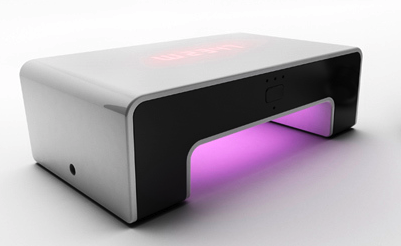Filed under: Interaction Design, Internet Life | Tags: Ambient Feedback, Electricity Monitor, Green Products, Product Review | Comments Off on Visualising the Invisible – The Wattson

At the Tent London show during last week’s London Design Festival we came across the wonderful Wattson, produced by DIY Kyoto. The Wattson is a device for tracking and visualising your household or business electricity use, a great example of ambient feedback that we’ve touched on before.
The Wattson shows you either a gentle blue glow to indicate that your household electricity usage is reasonable, or a choice of kilowatts or pounds spent over a year based on your current electricity consumption. The yearly figure is a great way to inject fear into your wallet and encourage reduced electricity consumption, so much so that DIY Kyoto are seeing 20% reductions in electricity usage amongst users of their Holmes software who sign up to their website. That’s a great achievement, and all the better for being achieved by the carrot of positive feedback rather than the stick of fines and taxes.
The Wattson we bought at the show is a lovely piece of engineering, from a team of product engineers part funded by NESTA (a non-government body that funds creative innovation – in full disclosure I did use to work for them). The unit works by attaching round the main electric wire that comes into your house or flat, and then transmitting a signal to the main Wattson box that sits, visibly, in your living room. The transmitter is powered by four AA batteries (supplied) and the display unit has a charger, or can be powered by the USB connector through which you can also connect to the free software to review your consumption (figures are stored in the Wattson for the last 4 weeks).
This is all very exciting and I’m looking forward to getting ours working.. the only problem right now is that the standard transmitter connector only goes round standard electrical wires and our flat has a shielding, thick cable going straight into a junction box! The Wattson website rightly advises that you employ a professional electrician in these situations. So you’ll have to wait a bit longer for some proper feedback on how it works in practice. In the meantime we’ll just keep turning off lights and un-plugging our TV without knowing which activity is really having the most impact.
Filed under: Interaction Design, Technology | Tags: Ambient Feedback, Green Thinking, Interaction Design | No Comments »
A few years back an American company, Ambient Devices, came up with an idea. They thought to themselves that if people could see how much electricity they were using, they would know when they are using a lot of it and then decide to turn off a few hair dryers, etc to cut down. Hmm.. but how to let people see how much magical, invisible energy they are using? Surely we just can’t know these days because so many things just use electricity in a non-obvious way, such as being on standby!

Ambient Devices’s answer? The Energy Orb, a small sphere that sits someone in your house, and glows different colours depending on your energy consumption. Using a lot of juice? The orb glows red and you know to cut back. Even with all the lights off you may be surprised to see how much the sphere still indicates you’re using, and that is its genius – it takes an invisible, dynamic system and presents it to you in an easily accessible manner.
This is all a very clever and engaging use of modern technology. Bright colours. Saves money on your electricity bills, and consequently the environment. Now a few more companies have jumped on the band wagon, producing more functional devices that give you up to the second energy usage in a manner that’s easy to absorb without really having to look for it.
Ambient Feedback is a great concept, and one that’s close to my heart, but is it actually new? Not really, it’s just a necessary evolution as we move further from the physical world to the less visible world of the internet and micro-electronics. In the days of my youth we already had a feedback mechanism that told us we were using too much electricity.. it was called the electricity meter. We knew immediately how much energy was being used by how many precious 50 pence pieces were going into the slot, and how empty the 50p bowl next to the meter had gotten since we last topped it up. Simple, and very easy to understand!
Of course there were times when this mechanism failed as no 50 pence pieces could be found anywhere in the house in the middle of the night, so I’m certainly not suggesting we move away from the wonders of Direct Debit, but it’s worth remembering how these things used to naturally be represented to us in a way that we never appreciated at the time. Then this knowledge can be used to make better, more relevant and useful interfaces to solve problems in our modern lives.
